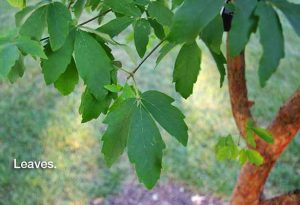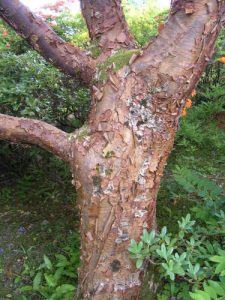Name That Tree
By Mary Francis, Fairfax Master Gardener Intern

Leaves
This maple has a low branching, rounded crown. The trifoliate leaves are green in summer with gray undersides (the species name means gray in Latin) and have a pleasing effect in a breeze. Flowers are inconspicuous and not showy. The fruit is a two-winged, brown samara with a dry, hard covering. In fall, the warm red color of the leaves takes center stage. It is one of the last maples to develop color in the fall, but worth the wait as it is very showy and unabashedly red. The leaves may persist into winter. Paperbark maple has sublime beauty in winter. When it snows, the flakes tuck themselves into the peeling surfaces of the bark, emphasizing the colors as well. The winged fruit persists during winter, providing further adornment.
 Paperbark maple is native to central China. Propagation traditionally has been by seeds, of which less than 5 percent germinate over three years. It is a slow growing tree, reaching a height of 15 to 30 feet at maturity with a similar spread. It prefers full sun to part shade in a sheltered location. It is hardy in zone 4 to zones 7 or 8. It prefers alkaline or slightly-acidic soils but will accommodate a wide pH range. The branches are resistant to breakage, with little pruning needed to develop a strong structure. It prefers moist, well-drained soil and will tolerate a variety of soil types.
Paperbark maple is native to central China. Propagation traditionally has been by seeds, of which less than 5 percent germinate over three years. It is a slow growing tree, reaching a height of 15 to 30 feet at maturity with a similar spread. It prefers full sun to part shade in a sheltered location. It is hardy in zone 4 to zones 7 or 8. It prefers alkaline or slightly-acidic soils but will accommodate a wide pH range. The branches are resistant to breakage, with little pruning needed to develop a strong structure. It prefers moist, well-drained soil and will tolerate a variety of soil types.
No great beauty is without flaws, and A. griseum is no exception. It is relatively easy to grow, but the leaves may scorch in dry summers. It is susceptible to verticillium wilt. Its tolerance to drought is only moderate. It may be hard to find and expensive to buy.
Two hybrids between A. griseum and A. nikoense are interesting. ‘Cinnamon Flake’ has bark that flakes into smaller strips than the species. The stem surface often appears pleated. ‘Gingerbread’ has fine bark that may present color in a wavy pattern.
References
Acer griseum, Oregon State University College of Agriculture, Department of Horticulture
Acer griseum, North Carolina State Extension
Acer griseum, University of Connecticut Plant Database